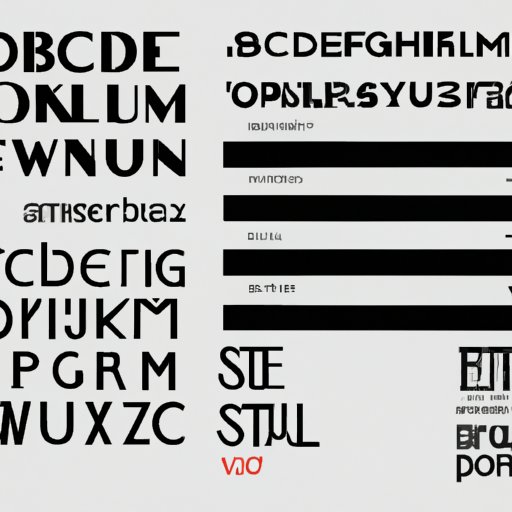Introduction
When it comes to designing a book, choosing the right font is one of the most important decisions a designer can make. A font can be defined as a set of characters or symbols that have a common design. In books, fonts are used to convey information clearly and effectively. But with so many fonts available, how do you decide which one is best for your book? This article will explore the most commonly used fonts in books, analyzing trends in typesetting and offering advice on how to choose the right font for your book.

Analyzing the Most Common Fonts Used in Books
When it comes to selecting a font for book design, designers often look to popular fonts that have been used in books throughout history. These fonts include classic serif typefaces such as Garamond, Caslon, and Baskerville, as well as modern sans serif fonts like Helvetica, Futura, and Avenir. While these fonts may have been used in books for centuries, there are also newer typefaces that have become increasingly popular in recent years.
Examining Popular Fonts for Book Designers
One of the most popular fonts for book design is Adobe Garamond Pro. This classic serif font has been used in books for centuries and continues to be a favorite among book designers today. Other popular fonts include Minion Pro, Adobe Jenson Pro, and Hoefler Text. These fonts are all highly legible and versatile, making them ideal for book design. For contemporary books, designers may opt for more modern fonts such as Gotham, Proxima Nova, Akzidenz Grotesk, and Avenir.

Exploring Typesetting Trends for Contemporary Books
In addition to selecting a font, book designers must also consider other elements of typesetting such as line spacing, kerning, and leading. These elements are essential for creating a readable and aesthetically pleasing layout. For contemporary books, designers often opt for larger type sizes and generous line spacing in order to create a clean and inviting layout. Additionally, they may use a combination of serif and sans serif fonts to create contrast and visual interest.

Finding the Right Font for Your Book
When selecting a font for your book, it’s important to consider both the style of the book and the preferences of the publisher. Many publishers prefer serif fonts for their books, as they are thought to be more legible and easier to read. However, some publishers prefer sans serif fonts, which are believed to be more modern and visually appealing. Ultimately, the choice of font should be based on the overall design of the book and the publisher’s preferences.
What Do Publishers Prefer – Serif or Sans Serif?
The answer to this question depends on the publisher and the type of book being designed. Generally speaking, most publishers prefer serif fonts for their books. These fonts are thought to be more legible and easier to read. However, some publishers may prefer sans serif fonts for their contemporary books, as these fonts are thought to be more modern and visually appealing.
How to Choose the Perfect Font for Your Book’s Layout
When selecting a font for your book, it’s important to consider both the style of the book and the preferences of the publisher. Start by researching the most popular fonts used in books and then experiment with different combinations of fonts to find the right one for your book. Once you’ve selected the font, consider other elements of typesetting such as line spacing, kerning, and leading to create a readable and aesthetically pleasing layout.
Conclusion
Choosing the right font for your book is an important decision. Popular fonts for book design include classic serif typefaces such as Garamond, Caslon, and Baskerville, as well as modern sans serif fonts like Helvetica, Futura, and Avenir. When selecting a font, it’s important to consider both the style of the book and the preferences of the publisher. Ultimately, the choice of font should be based on the overall design of the book and the publisher’s preferences. With the right font, you can create a beautiful and inviting layout for your book.


